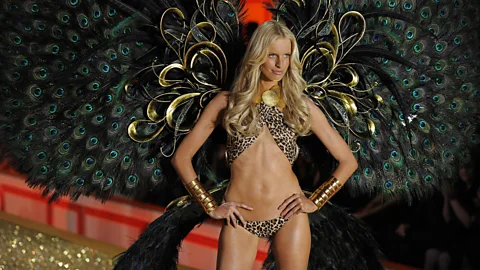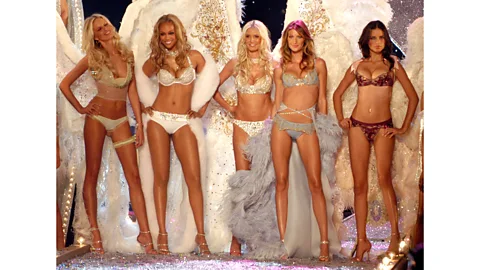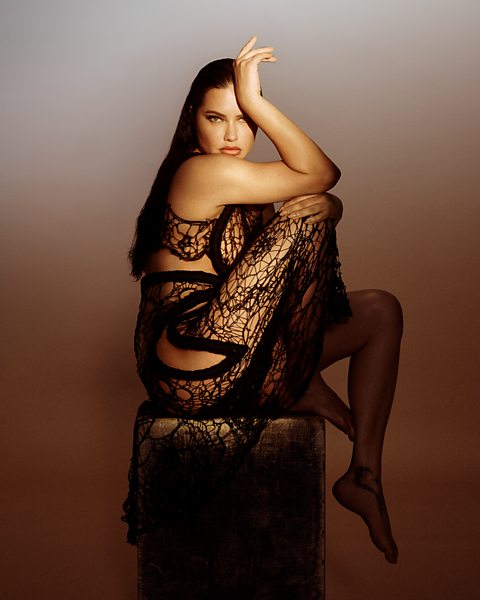Can Victoria's Secret fix its image?
 Getty Images
Getty ImagesVictoria's Secret: The Tour '23 is a new film on Prime Video that aims to re-cast the famous lingerie brand's problematic image. Can it succeed, asks Faran Krentcil.
Five minutes into the new Amazon Prime film, Victoria’s Secret: The Tour ’23, the 28-year-old supermodel Gigi Hadid laughs sweetly into the camera. Then she says the f-word. It's a surprising move from the mass-market brand, which turned lingerie from a French luxury into an all-American staple when it became a popular mall store in the 1980s. With its shiny pink shopping bags and velvet-lined dressing rooms, Victoria's Secret was a staple for bras and underwear that lured millions of US women by making sexy lingerie as accessible as a pair of blue jeans.
More like this:
As Victoria's Secret became a rite of age for teen shoppers buying their first "grown-up" bras, its models – era-defining bombshells like Tyra Banks, Heidi Klum, Gisele Bündchen – became household names, too. In 1998, the label capitalised on their friendly-but-glamorous appeal with the Victoria's Secret Fashion Show, a televised catwalk event that turned mere models into "Angels" with push-up bras, stilettos, and massive feathered wings. At its peak in the mid-2000s, the annual show was so popular that it earned its own Hollywood Walk of Fame.
 Getty Images
Getty ImagesBut it's been five years since the last Victoria's Secret show, and things have changed. The brand's former vibe (thin, tanned models, thrilled to wink and wave at the audience of men cheering nearby) is no longer welcome to shoppers demanding inclusion and autonomy. And so the palace of pink dreams has changed, reshaping itself as a vehicle for inclusive, invincible self-love.
You can still buy the bras, though – in fact, Victoria's Secret is counting on it.
Just debuted on Amazon Prime, Victoria’s Secret: The Tour '23 is part documentary, part music video, and part luscious commercial for corset tops and underwear. The movie stars Hadid along with new Victoria's Secret models like Adut Akech and Winnie Harlow, plus a female collective of artists dubbed "the VS 20".
The film embraces "the best of our past… and also a very 'now' moment in our culture," Raùl Martinez, Victoria's Secret executive vice president and creative director, tells BBC Culture. "Of course we have the wings, still – but how do we introduce them in a contemporary space? That’s what Victoria's Secret: The Tour is about."
By giving its past life a knowing wink – albeit one still coated in fabulous mascara – Victoria's Secret aims to maintain its force as a cultural phenomenon. In that way, it has strong parallels with Barbie, the summer's cinema hit that reshaped Mattel's dated image by turning its once-plastic glamour into glittery, subversive strength. "I have heard some comparisons," agrees Martinez.
 Victoria's Secret
Victoria's SecretMartinez ed Victoria's Secret from Vogue in 2020, when the brand was reeling from associations with the #MeToo movement, and implied links to Jeffrey Epstein. Former catwalk models Bridget Malcolm and Dorothea Barth Jorgensen spoke out on the brand's punishing size standards. Then-president Ed Razek insulted transgender women in a Vogue interview. And a 2022 documentary by Matt Tyrnauer called Victoria's Secret: Angels and Demons connected all the dots, making the brand ripe for online cancellation.
Indeed, sales have fallen since their 2016 peak, when the brand earned more than $7.7bn in revenue. Brands like Aerie, Skims and Parade, along with in-house offerings at Target and Walmart, have challenged their market share. At their worst year in 2020, the brand barely pulled in $5bn – an especially shocking fall, given how much of their merchandise was the same type of athleisure and underwear most women spent the pandemic wearing. But even with the erosion of mall culture, Victoria's Secret earnings fell just 6% to $6.34 bn in 2022. In March of this year, they projected an annual net sales increase in the "mid-single digit range." Not huge by their standards – but also a gain of tens of millions.
"The thing that people don't really realise is [that] the supply chain for underwear – for bras, in particular – is really dominated by them," Lauren Sherman, a Puck fashion analyst who is co-writing an book on the brand, tells BBC Culture. "They generate the most sales; they sell more bras than pretty much any other single brand retailer."
"They have the retail footprint and the brand footprint to stay afloat even in tough times," adds Elka Gruenberg, a lingerie expert who's worked with everyone from discount chain Steve & Barry's to luxury department store Bergdorf Goodman. "Now they need to connect with every shopper across the spectrum. Of course," she adds, "Gen Z is important."
Slow to adapt
For years, part of Victoria's Secret's appeal was its Pink label, which blended cartoon puppies and push-up bras for teens and college students. But the brand was slow to adapt to inclusive sizing and gender fluidity, and for women now in their 20s, the label can still symbolise feelings of inadequacy. "Victoria's Secret has been embedded in my brain for quite some time as an aspiration," explains Jasmine Wallis, 27, a content strategist and podcaster who hosts the Gen Z podcast Culture Club. "I came of age when the frenzy was at its peak. The wings. The very thin women. It never felt like I belonged there. It never felt like it was speaking to me. So how can it start now">window._taboola = window._taboola || []; _taboola.push({ mode: 'alternating-thumbnails-a', container: 'taboola-below-article', placement: 'Below Article', target_type: 'mix' });
